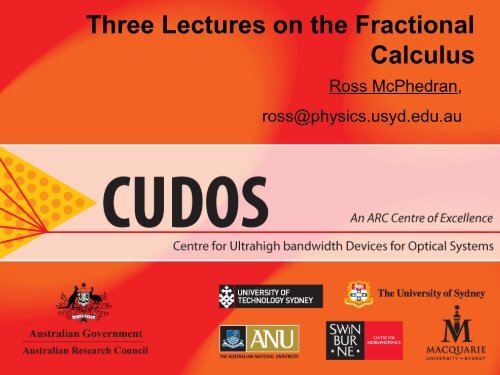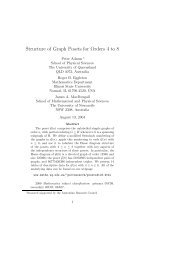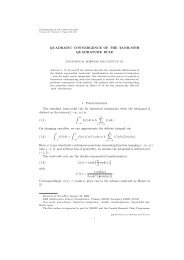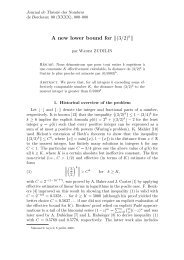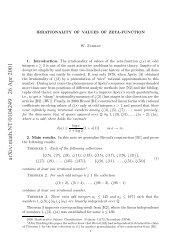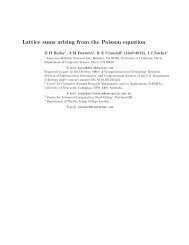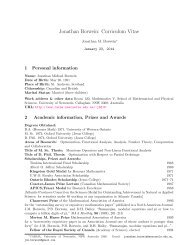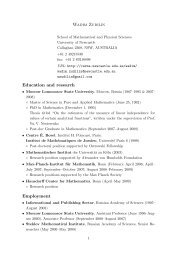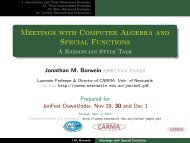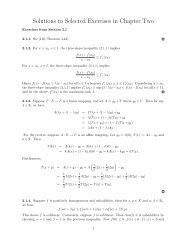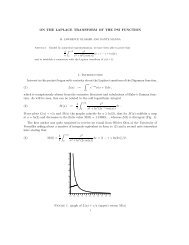Lectures on Fractional Calculus - CARMA
Lectures on Fractional Calculus - CARMA
Lectures on Fractional Calculus - CARMA
Create successful ePaper yourself
Turn your PDF publications into a flip-book with our unique Google optimized e-Paper software.
Three <str<strong>on</strong>g>Lectures</str<strong>on</strong>g> <strong>on</strong> the Fracti<strong>on</strong>al<strong>Calculus</strong>Ross McPhedran,ross@physics.usyd.edu.au
• Motivati<strong>on</strong>, history• Fracti<strong>on</strong>al calculus of <strong>on</strong>e variableOutline• Fourier transforms, Green’s functi<strong>on</strong>s anddistributi<strong>on</strong>s• Laplacian in two dimensi<strong>on</strong>s to an arbitrarypower
References• A child’s garden of fracti<strong>on</strong>al derivatives, MarciaKleinz and Tom Osler• Mathematica for theoretical physics, Gerd Baumann,Springer 2004, Chapter 7.• Fracti<strong>on</strong>al kinetics, I.M .Solokov, J. Klafter and A.Blumen,Physics Today, November 2002, pp. 48-54• Electromagnetic processes in dispersive media, D.B. Melrose and R.C. McPhedran, CambridgeUniversity Press 2005, Chapters 4,5.
Motivati<strong>on</strong>, History• In the late 17 th century calculus hadtransformed mathematics and physics- wherewere its boundaries?• Letter from Leibnitz to l’Hospital: Can themeaning of derivatives with integral order n betransformed to n<strong>on</strong>-integral, even complex,orders?• Difficulties arose: Leibnitz: Il y a del’apparence qu’<strong>on</strong> tirera un jour desc<strong>on</strong>sequences bien utiles de ces paradoxes,car il n’y a gueres de paradoxes sans utilite
Motivati<strong>on</strong>, History (2)• Initial motivati<strong>on</strong>: curiosity. Major c<strong>on</strong>tributi<strong>on</strong>sfrom Liouville, Riemann, Laplace, Heaviside,Weyl, etc• Well established mathematical frameworknow finding applicati<strong>on</strong>s• Differentiati<strong>on</strong> makes functi<strong>on</strong>s nastier;integrati<strong>on</strong> makes them better; fracti<strong>on</strong>aldifferentiati<strong>on</strong> can make them “just right”. Seethe Physics Today article.
Scope of Fracti<strong>on</strong>al <strong>Calculus</strong>• Differentiati<strong>on</strong> with respect to arbitrarypowers: they can be negative• Negative differentiati<strong>on</strong> is integrati<strong>on</strong>• Integrati<strong>on</strong> needs two limits to have a precisemeaning• Fracti<strong>on</strong>al derivatives in general need a lowerlimit, and a variable indicated Da,xαα- orderofdifferentiati<strong>on</strong> or integrati<strong>on</strong>a lower limit; x variable
Fracti<strong>on</strong>al Differentiati<strong>on</strong> (1)d n x mdx n = m!(m−n)! xm−nm! =Γ(m +1)d n x mdx n = Γ(m+1)Γ(m−n+1) xm−n• This is the Riemann-Liouville derivative.• Can be applied to functi<strong>on</strong>s representedby Taylor series• n can be any real or complex number
Fracti<strong>on</strong>al Differentiati<strong>on</strong> (2)d n x mdx n = Γ(m+1)Γ(m−n+1) xm−n1Γ(x)x• The result will be zero ifm-n+1 is zero or anegative integer;• Otherwise its n<strong>on</strong>-zerom =0:d n 1dx n = x−nΓ(1−n)e.g.d 1/2 1dx 1/2 = 1 √ πx
Factorial Functi<strong>on</strong>Key equati<strong>on</strong>s for the gamma functi<strong>on</strong> are:Γ(z +1)=zΓ(z) =z! =z(z − 1)!, (1)Γ(1) = 1, (2)Γ(z) = R ∞t z−1 e −t dt, 0, (3)0andΓ(z)Γ(1 − z) =πsin(πz) . (4)From (4) <strong>on</strong>e can prove other useful things-e.g.,Γ(1/2) = √ π (5)andΓ(−n + δ) = (−1)nn!δ . (6)
Fracti<strong>on</strong>al Differentiati<strong>on</strong> (3)d n x mdx n = Γ(m+1)Γ(m−n+1) xm−n¡d p d¢ n x mdx p dx =Γ(m−n+1)n Γ(m−n−p+1)Γ(m+1)Γ(m−n+1) xm−n−pi.e.¡d p d¢ n x mdx p dx =Γ(m+1)n Γ(m−n−p+1) xm−n−pExample:³d 1/2dx 1/2d 1/2 1dx 1/2 ´=Γ(1)Γ(1−1/2−1/2) x−1 =0
A Fracti<strong>on</strong>al Differentiati<strong>on</strong>C<strong>on</strong>undrumWeknowforanyintegern:D n (e ax )=a n e axso we want for any αD α (e ax )=a α e ax .Yet:D α e x = D α ( P ∞n=0 xnn! )=P ∞n=0x n−αΓ(n−α+1)These d<strong>on</strong>’t match unless α is an integer!
Integrati<strong>on</strong> as Negative Differentiati<strong>on</strong>t 2t 1t 1xxt 2t 2t 1We c<strong>on</strong>sider the definite integrals:D −1 f(x) = R x0 f(t)dt, D−2 f(x) = R x R t20 0 f(t 1)dt 1 dt 2 .In the sec<strong>on</strong>d integral, we invert the order of integrati<strong>on</strong>s,going from left to right diagrams above.D −2 f(x) = R x R x0 t 1f(t 1 )dt 2 dt 1 = R x0 f(t 1)(x − t 1 )dtR 1D −3 f(x) = 1 x2 0 f(t 1)(x − t 1 ) 2 dtR 1D −n f(x) = 1 x(n−1)! 0 f(t 1)(x − t 1 ) n−1 dt 1
Integrati<strong>on</strong> as NegativeDifferentiati<strong>on</strong>(2)We generalize RD −n f(x) = 1 x(n−1)! 0 f(t 1)(x − t 1 ) n−1 dt 1to give RD −α f(x) = 1 xΓ(α) 0 f(t 1)(x − t 1 ) α−1 dt 1For the singularity at t 1 → x to be integrable, we requireα > 0, c<strong>on</strong>firming we are dealing with a negative order ofdifferentiati<strong>on</strong>.So we write our generalized differential operator with acurly D, putting its order as the superscript,and the lower limit and variable being differentiatedas subscripts. The two usual choices for lowerlimits are 0 and −∞.D α a,x
Integrati<strong>on</strong> as NegativeDifferentiati<strong>on</strong>(3)Being clear about implicit limits enables us to clear up theprevious difficulty:D −1b,x eax = R xb eax dx = eaxaif b = −∞D −1b,x xp = R xb xp dx = xp+1p+1if b =0For any given physical problem, there will be a choiceto make about the best value of lower limits.This choice will c<strong>on</strong>trol the results of differentiati<strong>on</strong>sto fracti<strong>on</strong>al powers.D0,x(x α p )= Γ(p+1)xp−αΓ(p−α+1)andD−∞,x(e α ax )=a α e ax
Differentiati<strong>on</strong> as Negative Integrati<strong>on</strong>We can define fracti<strong>on</strong>al differentiati<strong>on</strong> <strong>on</strong> the basisof fracti<strong>on</strong>al integrati<strong>on</strong>Da,x s =( dndx)D −(n−s)n a,x f(x)with n a positive integer, 0, 0.We have then some familiar properties- linearity:Da,x(αf(x)+βg(x)) s = αDa,xf(x)+βD s a,xg(x)sand compositi<strong>on</strong>Da,xD s a,xf(x) p =Da,x s+p f(x),with p0, see Baumann.For Leibnitz’s rule, we get an infinite series:Da,x(f(x)g(x)) q = P µ ∞ qj=0Dja,x q−j f(x)Da,xg(x),jwith the symbol in brackets beingΓ(q +1)/(Γ(j +1)Γ(q − j + 1)).
• Reprise from last lecture:Lecture 2- Fourier methodsd p x qdx= D p p 0,x = Γ(q+1)Γ(q−p+1) xq−pthe Riemann-Liouville derivative.Differentiati<strong>on</strong> to a negative power:Da,x −αf(x)= R 1 xΓ(α) a f(t 1)(x − t 1 ) α−1 dt 1for α > 0.Most discussi<strong>on</strong>s use fracti<strong>on</strong>al calculus in <strong>on</strong>evariable. Let’s see how we can treat two dimensi<strong>on</strong>s,using Fourier transform ideas.
Adding up Harm<strong>on</strong>ics• Fourier series- sines and cosines adding up togive arbitrary waveforms: harm<strong>on</strong>ics• Fourier transforms- not just harm<strong>on</strong>ics, but anintegral over all frequencies• In more than <strong>on</strong>e dimensi<strong>on</strong>, add up planewaves• In two dimensi<strong>on</strong>s, a plane wave isexp i(k x x + k y y)Wave vector:(k x ,k y )=k, momentum ¯hk
The Fourier transform• Represent a functi<strong>on</strong> in space as an integralover plane waves: inverse transformA(x) =A(x, y) = R dk x dk y(2π) 2 e i(k xx+k y y) Ã(k x ,k y )Functi<strong>on</strong> inspaceFuncti<strong>on</strong> in wave vectorspace; reciprocal space;momentum spaceDirect transform:Ã(k x ,k y )= R dxdye −i(k xx+k y y) A(x, y)
Momentum space• A lot of physics is based <strong>on</strong> momentum orwavevector space• C<strong>on</strong>servati<strong>on</strong> of momentum: p =¯hk• A mathematical reas<strong>on</strong>: derivatives arereplaced by algebraic operati<strong>on</strong>sA(x) =A(x, y) = R dk x dk y(2π) 2 e i(k xx+k y y) Ã(k x ,k y )∂∂x A(x) =R dk x dk y(2π) 2 e i(k xx+k y y) ik x Ã(k x ,k y )∂∂xPartial derivative with respect to x
The Laplacian• A particularly important operator in physics isthe Laplacian• Take two derivatives with respect to x, twowith respect to y and add• Crops up in electrostatics, magnetostatics,complex variable theory• Symbol:∇ 2 = ∂2∂x 2∂ 2∂x 2→−k 2 x+ ∂2∂y 2 ∂ 2∇ 2 →−(k 2 x + k 2 y)∂y 2→−k 2 y
The Laplacian (2)Once:n times:∇ 2 →−(k 2 x + k 2 y)∇ 2n → (−1) n (k 2 x + k 2 y) np timessince∇ 2p → e iπp (k 2 x + k 2 y) p(−1) n =cos(nπ)+i sin(nπ) =e iπn∇ 2p A(x, y) → e iπp (k 2 x + k 2 y) p Ã(k x ,k y )
The Dirac delta functi<strong>on</strong>• Fourier transforms integrate over extendedobjects: plane waves• Need a way of going from extended objects topoint-like objects• This is provided by the Dirac delta functi<strong>on</strong>:the Fourier transform of a c<strong>on</strong>stant2πδ(ω) = R ∞−∞ dteiωt(2π) 2 δ 2 (k x ,k y )= R ∞−∞ dxdyei(k xx+k y y)Delta functi<strong>on</strong> of angularfrequencyDelta functi<strong>on</strong> of wavevector (2D)
The Dirac delta functi<strong>on</strong> (2)• The more spread out a functi<strong>on</strong> is, the tighterits Fourier transform c<strong>on</strong>centrates around theorigin• A c<strong>on</strong>stant is spread out uniformly in space:its Fourier transform c<strong>on</strong>centrates around theorigin in reciprocal space• Another way of thinking about the deltafuncti<strong>on</strong> is that it is a functi<strong>on</strong> c<strong>on</strong>centratedaround the origin, but having unit area underits curve
The Dirac delta functi<strong>on</strong> (3)• One representati<strong>on</strong> is based <strong>on</strong> Gaussianfuncti<strong>on</strong>sf T (t) =e −t2 /T 2δ(ω) =lim T →∞→T2 √ π e−ω2 T 2 /4Functi<strong>on</strong> → c<strong>on</strong>stantTransform→ deltaf T (t)δ T (ω)T =10
Green’s functi<strong>on</strong>s• A Green’s functi<strong>on</strong> for a problem in physics isa soluti<strong>on</strong> of the governing equati<strong>on</strong>corresp<strong>on</strong>ding to a point source• The point source is just a delta functi<strong>on</strong>• So for example in electrostatics if we look forthe Green’s functi<strong>on</strong> for a point source at theorigin, we want to solve∇ 2 G(x, y) =−δ 2 (x, y)The minus sign is just a c<strong>on</strong>venti<strong>on</strong>: other authorshave a plus sign
Green’s functi<strong>on</strong>s (2)• Once you have the Green’s functi<strong>on</strong> for apoint source, you can get the soluti<strong>on</strong> for anarbitrary set of sources by summing theGreen’s functi<strong>on</strong> multiplied by the strength ofthe source• You know well the potential for a pointelectrostatic charge in 3D:G(x, y, z) = 14πr , r = p x 2 + y 2 + z 2
The Green’s functi<strong>on</strong> in 2DWe start with(2π) 2 δ 2 (k x ,k y )= R ∞−∞ dxdyei(k xx+k y y)and∇ R 2 ∞−∞ dxdyei(k xx+k y y) =− R ∞−∞ dxdy(k2 x + k 2 y)e i(k xx+k y y)HenceG(x, y) = 14π 2 R ∞−∞R ∞−∞e i(k xx+ky y)(k 2 x +k2 y )Theintegralisd<strong>on</strong>einpolarcoordinates:k x = r cos(θ), k y = r sin(θ).
G(x, y) = 14π 2 R ∞−∞R ∞−∞The Green’s functi<strong>on</strong> in 2D (2)e i(k xx+ky y)(k 2 x +k2 y )In R polar coordinates, the angular integral is:π−π exp(ikr cos θ) =2πJ 0(kr).Here J 0 (z) is theBessel functi<strong>on</strong> of order zero(of the first kind).This gives usR ∞0G(x) =G(r) = 12πdk J 0(kr)k.If we require that G(r) vanishatr = a, wegetG(r) = 12πR ∞0dk J 0(kr)−J 0 (ka)k.
R ∞0The Green’s functi<strong>on</strong> in 2D (3)G(r) = 12πdk J 0(kr)−J 0 (ka)k.We evaluate this using Frullani’s integralI(a, b) = R ∞dx [f(ax)−f(bx)]0 x, a>0,b>0and f(x) isc<strong>on</strong>tinuousatx =0. ThenI(a, b) =f(0) ln(b/a).HenceG(r) = 12π ln ¡ ¢ar .This is the 2D Green’s functi<strong>on</strong>. It satisfies∇ 2 G(r) =−δ 2 (x), |x| = r.
Lecture 3- Green’s Functi<strong>on</strong>s forFracti<strong>on</strong>al OperatorsG(r) = 12π ln ¡ ¢ar .This is the 2D Green’s functi<strong>on</strong>. It satisfies∇ 2 G(r) =−δ 2 (x), |x| = r.Thequesti<strong>on</strong>weanswerhereis:What does this Green’s functi<strong>on</strong> become ifwe want to have the operator ∇ 2s ,s arbitrary real or complex?
A Neat TrickWe know the Green’s functi<strong>on</strong> for the Laplacian:G 2 (r) =− 12π ln(r)gives∇ 2 G 2 (r) =−δ 2 (x, y)We want to know what G 2s is for which∇ 2s G 2s (r) =−δ 2 (x, y)We write∇ 2 G 2 (r) =∇ 2s (∇ 2−2s G 2 (r))Then quite simply:G 2s (r) =∇ 2−2s G 2 (r)So all we need is to apply the Laplacian to an arbitrarypower to the log functi<strong>on</strong>!
Technical Details (1)To carry out this calculati<strong>on</strong>, we first need to know∇ 2s r β . It is obvious that each sec<strong>on</strong>dderivative reduces the power of r by 2, so∇ 2s r β = K(r, β)r β−2sfor some K(s, β) which depends <strong>on</strong> β and s,but not r.To evaluate K(s, β) we need Weber’s integral:R ∞0r s J 0 (αr)dr =Γ(1+s2 )2sΓ( 1−s2 )α1+s
Technical details (2)We write down the Fourier transform of r β :r β = R ∞ R ∞ Γ(1+β/2)e 2πi(k xx+k y y) dk−∞ −∞ Γ(−β/2)π β+1 k β+2 x dk y .To check this expressi<strong>on</strong>, c<strong>on</strong>vert the double integral toan integral over angle multiplied by an integral over kdk.The integral over angle gives the Bessel functi<strong>on</strong>2πJ 0 (2πkr). You then get2Γ(1+β/2)R ∞k −1−β dkJΓ(−β/2)π β 00 (2πkr).You then use Weber’s integral to verify the result.
Differentiati<strong>on</strong> of the Logarithm∇ 2s (r β )=i 2s 2 2s Γ(1+β/2)Γ(−β/2)Γ(s−β/2)Γ(1−s+β/2) rβ−2sSuppose we expand this taking β small:r β = e β ln r ' 1+β ln r.Then this will tell us how ∇ 2s operates <strong>on</strong> a c<strong>on</strong>stant and ln r.The <strong>on</strong>ly term which causes any problem is1Γ(z) ' z, for |z|
• So we have deduced:G 2s (r) = −r2s−2 Γ(1−s)π(2i) 2s Γ(s)Only for s→ 1 will we get a logarithm!Γ(s)Γ(1−s) r−2s ,∇ 2s (ln r) ' −i 2s 2 2s−1so that∇ 2−2s (ln r) ' −i 2−2s 2 2−2s−1 Γ(1−s)Γ(s)r −2+2sThe Final AnswerWe have also learned that Fourier transforms can beused as a way of evaluating fracti<strong>on</strong>al derivatives.


